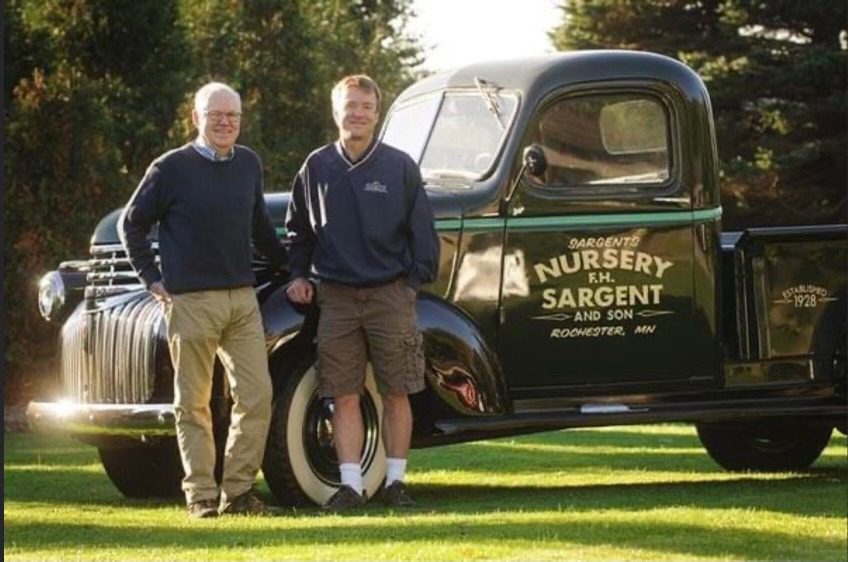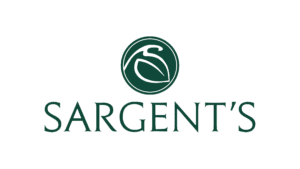Reflections on Sargent’s Landscape Nursery’s Fifty Years
Today, as they celebrate their fiftieth anniversary, Sargent’s Nursery, Inc. is a major player in the greater Rochester’s nursery/garden center/landscape business. When Sargent’s first opened in March 1971 on leased space on the north end of the Miracle Mile Shopping Center, it wasn’t clear or guaranteed that they would have the growth and success they have had. Many steps would need to be taken to lead the business into the “modern era” where the economy is strong, the company has the inventory, employees, and equipment to meet their customers’ needs, and many of their employees have careers with year-round employment rather than jobs with seasonal work.
Sargent’s relocated from their Miracle Mile location in 1976 to forty acres north of town (Sargent’s North) and in 1985 they opened Sargent’s on 2ND. These moves positioned the business for growth in the decades that followed. Around 2010, competition from big-box stores—Home Depot and Lowes, for example—and e-commerce significantly changed the nursery/landscape industry, and independent garden centers were struggling to hold their place in the market. Sargent’s needed to fine-tune its operations, and their growing greenhouse became part of their strategy. They added services to differentiate them from the mass merchants and developed unique and specialty products for the same reason. Landscape design became an even more significant way to compete, and they specialized in the “design build” business. In other words, their designers created a unique product and their crews built it. Outdoor living spaces have become as important to homeowners as their indoor spaces.
Ultimately, the core differentiator between Sargent’s and their big-box store competitors is that they create an experience for their customers that none of them can match. People look forward to, and enjoy, coming to their stores to shop much like they enjoy dining at their favorite restaurant or going on their favorite vacation.
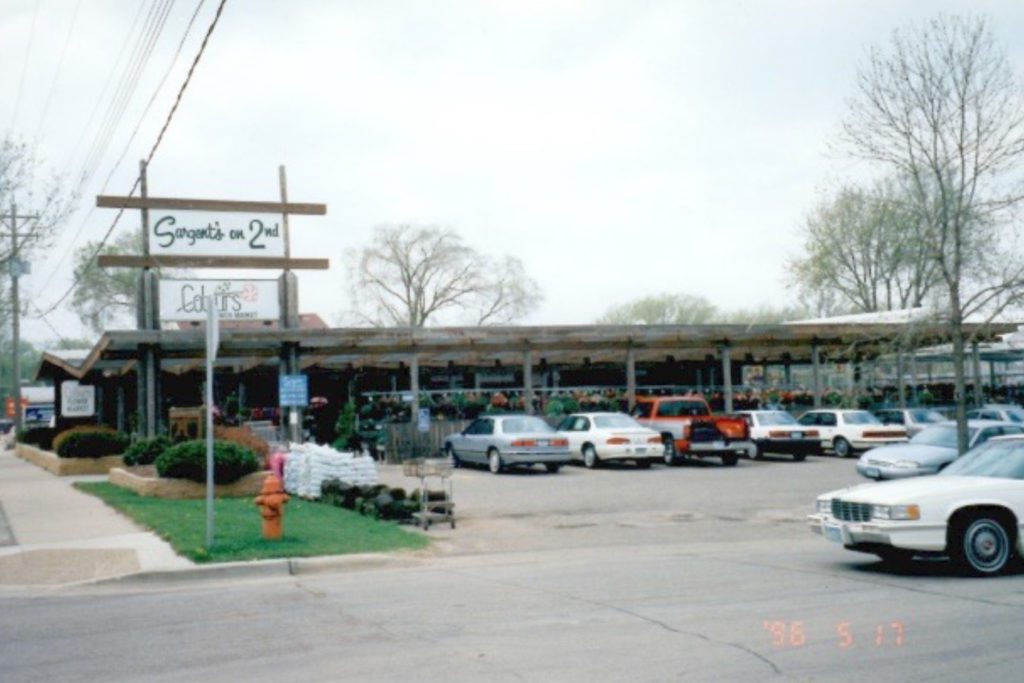
Sargent’s on 2nd, 1996
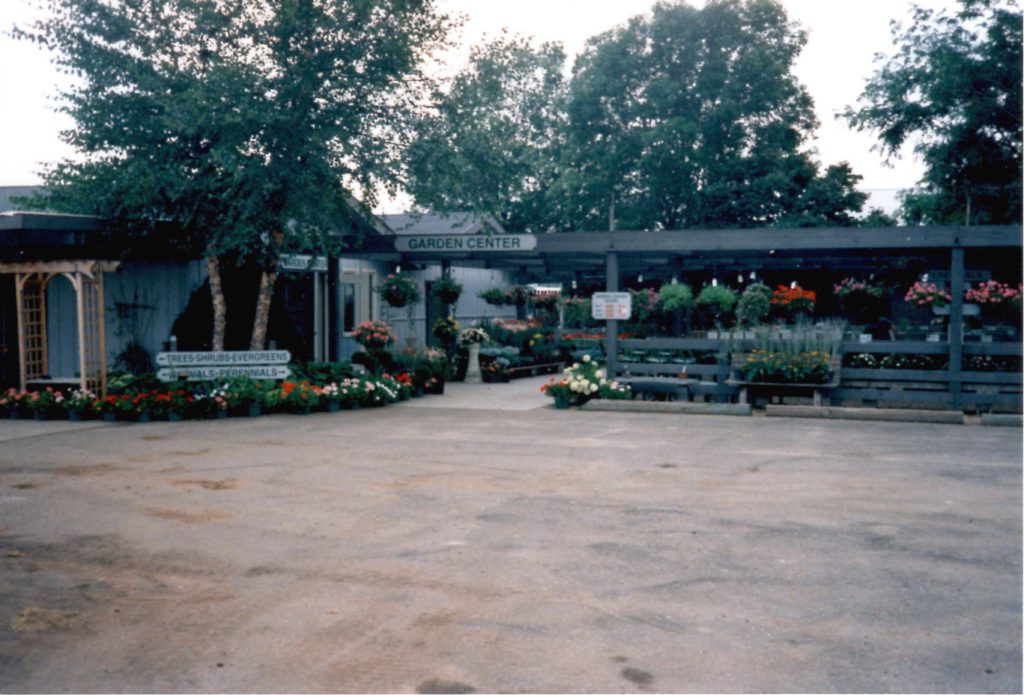
Sargent’s North, pre-2000
BUSINESS PHILOSOPHIES
Sargent’s success did not happen by chance, rather due to following several key philosophies:
– Stay focused on the core business: From the very beginning, Sargent’s primary focus has been plant material based, whether that be trees, shrubs, annual flowers, or perennial flowers. In addition, they focus on using these plants in the home or commercial landscape with landscape design, landscape installation, hardscape installations, and landscape maintenance (now called garden services).
They have had a relatively even mix of retail garden center sales and landscape installation sales. For the last decade, the ratio has been about 40% landscape sales and 60% retail sales, combining the two garden centers. The two areas (the do-it-yourself retail and landscape installation) have a nice symmetry, and each department supports the other. Some retail customers decide they want landscaping installed, and some people want to use custom designs and install the landscaping by themselves. The production departments for the nursery and the annuals and perennials and the woody plant support team all give depth and crucial support to the garden center and landscape departments.
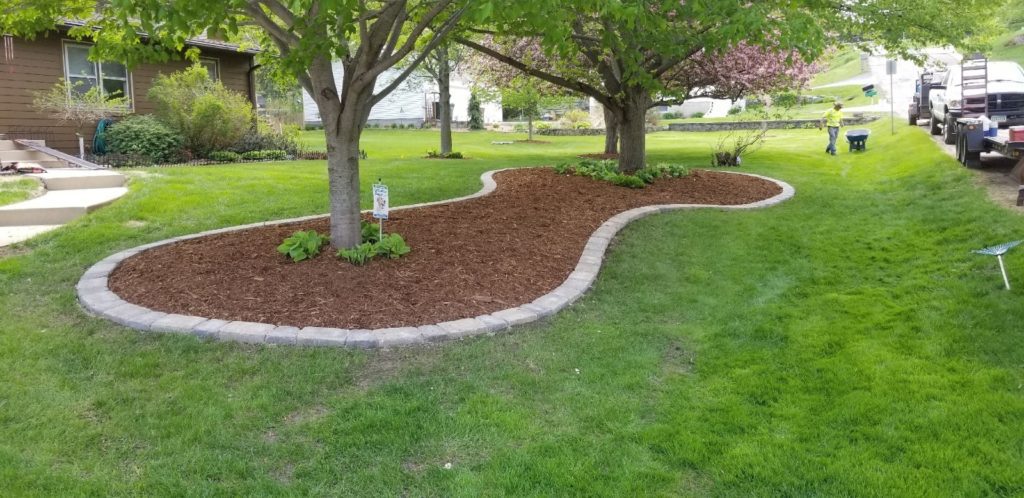
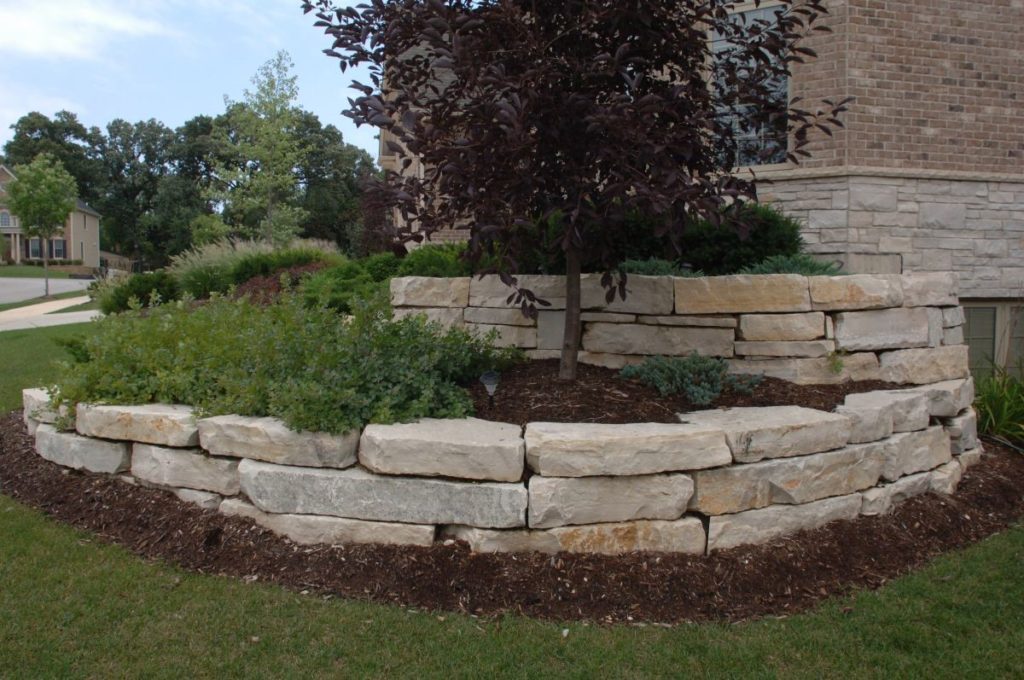
– Gain customer confidence and loyalty: The underlying business plan Sargent’s pursued was to be known as “a field grower of trees and evergreens and a greenhouse grower of annuals and perennials.” This allowed them to market the idea of “buying from the grower,” and that concept gave them credibility with the public. Customers could be confident in Sargent’s plant quality and knowledge and that they would stand behind their products. Buy from the grower was a consistent theme and a good business plan for them. To reinforce this idea, they implemented a two-year guarantee to assure their customers and set Sargent’s apart from competition. Their goal has been—and always will be—to keep customers for the long term and have them succeed with their plants and landscape projects. The “no quibble guarantee” became a mainstay of service to their customers, and many of them have been loyal for their lifetimes and through moves (buying or building) from home to home.
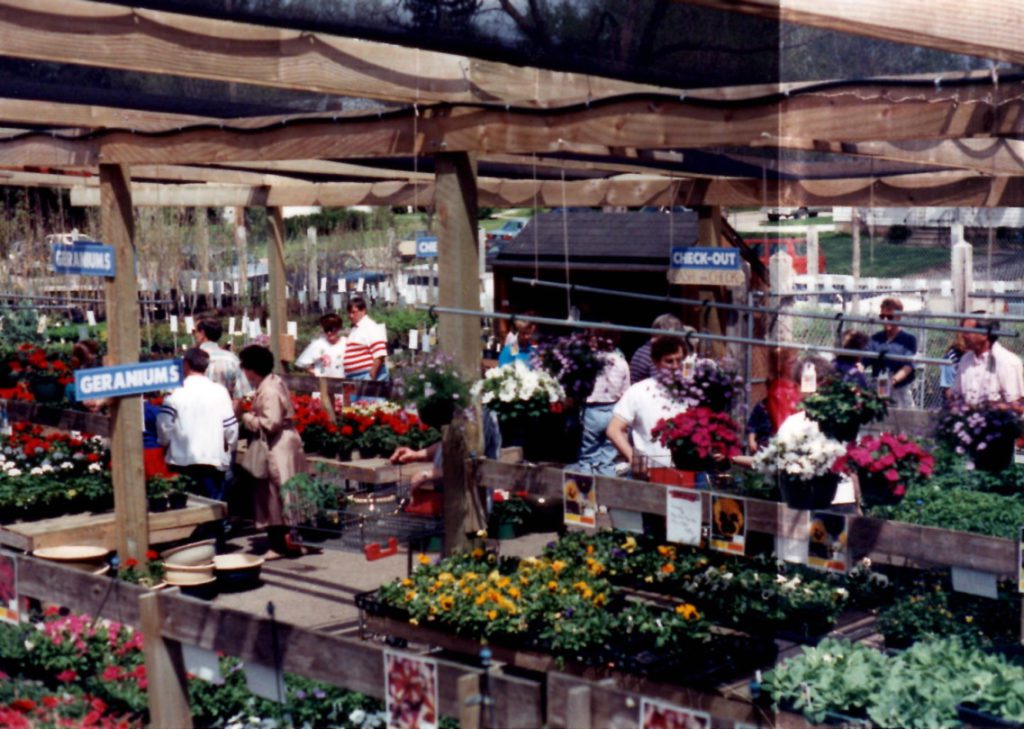
Customers shopping at Sargent’s on 2nd in the early 1990s
– Trust the employees: Forrest Sargent believes that his main talent and contributions to the business have centered on finding and hiring good people, trusting them, and giving them freedom to excel. Rarely was he let down. Their incredible talent, dedication, and loyalty have been instrumental in Sargent’s success.Customers shopping at Sargent’s on 2nd in the early 1990s
Paul Pike is Sargent’s greenhouse grower, woody plant buyer, and IT guru. He joined in 1979 and is still a key employee today. Scott Moon came in 1984 and has been their one and only manager of Sargent’s on 2ND. He frequently and capably represents Sargent’s on radio and TV. Jeff Rosburg joined in 1984 and has been the leader of their landscape department for much of his time with the company. Galen (Shorty) Kinsley, who joined in 1985, is the fleet manager, overall snow crew leader, and contact person with the Mayo Clinic grounds crew for snow work. Jeff Scharteau joined in 1986 and has been a leader in the landscape installation department and an invaluable trainer. Mike Frederickson has been the nursery foreman since 1990. Pete Lombard joined in 1990 and has been the main delivery driver and all-star mechanic. Cathy Hanson joined in 1995 and has been the highly valued assistant garden center manager at Sargent’s on 2ND. Sarah Bubbers has been Sargent’s human resources manager and an extremely dedicated, key employee in office management since 1996. Several other employees have been with Sargent’s for more than ten years.
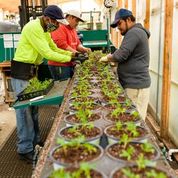 Potting on the production line
Potting on the production line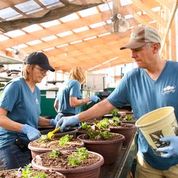 Fertilizing and potting larger pots
Fertilizing and potting larger pots
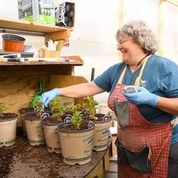
Lisa, enjoying potting perennials
– Refresh and renovate regularly: Business consultants advise that to stay relevant and up to date, a major building renovation should occur every ten years. Among the more significant Sargent’s updates were:
- 1986: New greenhouses to support Sargents on 2ND and a new office were built at Sargent’s North.
- 1995: Sargent’s on 2ND underwent a major facelift. They expanded the parking lot, installed automatic doors, built a heated and ventilated greenhouse to the north end of the store, and added considerable covered outside shopping space.
- 2002: A new garden center, retail greenhouse, office space, and shop were built at Sargent’s North.
- 2006: Sargent’s on 2ND had another major renovation. The remodeling included a refresh of the floral work area, new checkout kiosks, expansion of the interior store shopping area, a large garage for product storage, and some interior redecorating.
- 2009: A modern, high-tech greenhouse growing range for annual flower production was built at Sargent’s North.
- 2021: Sargent’s embarked on the planning of a major project involving the remodeling of Sargent’s on 2ND and purchasing the Hicks Electric property along Second Street Southwest to accommodate store growth. Look for a beautiful redesign and a new shop in 2022.
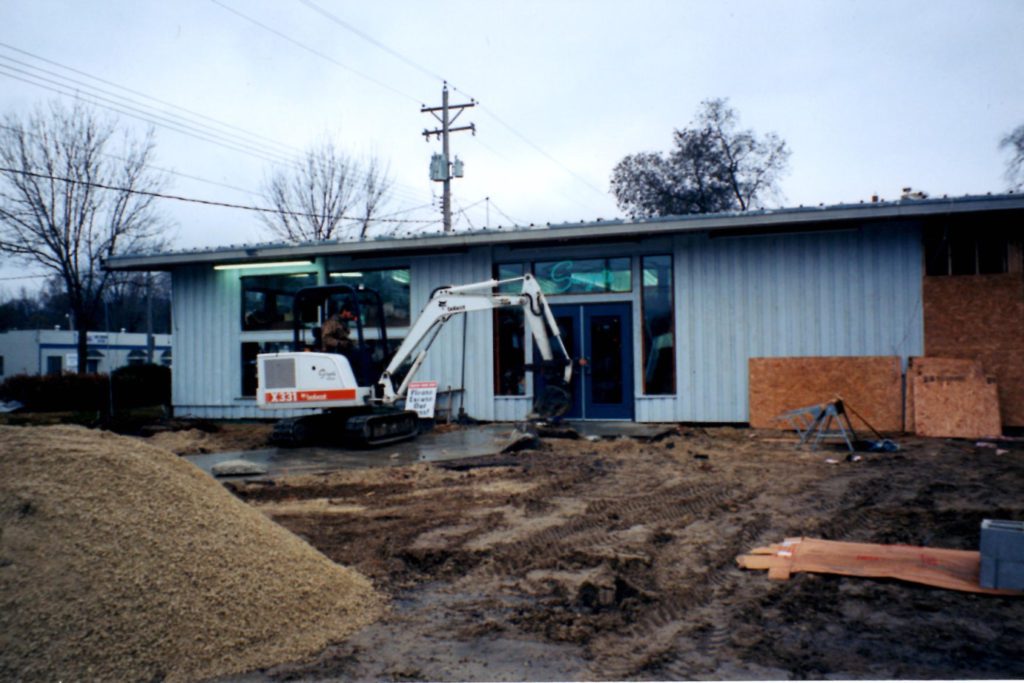
Sargent’s on 2nd renovation, 1995
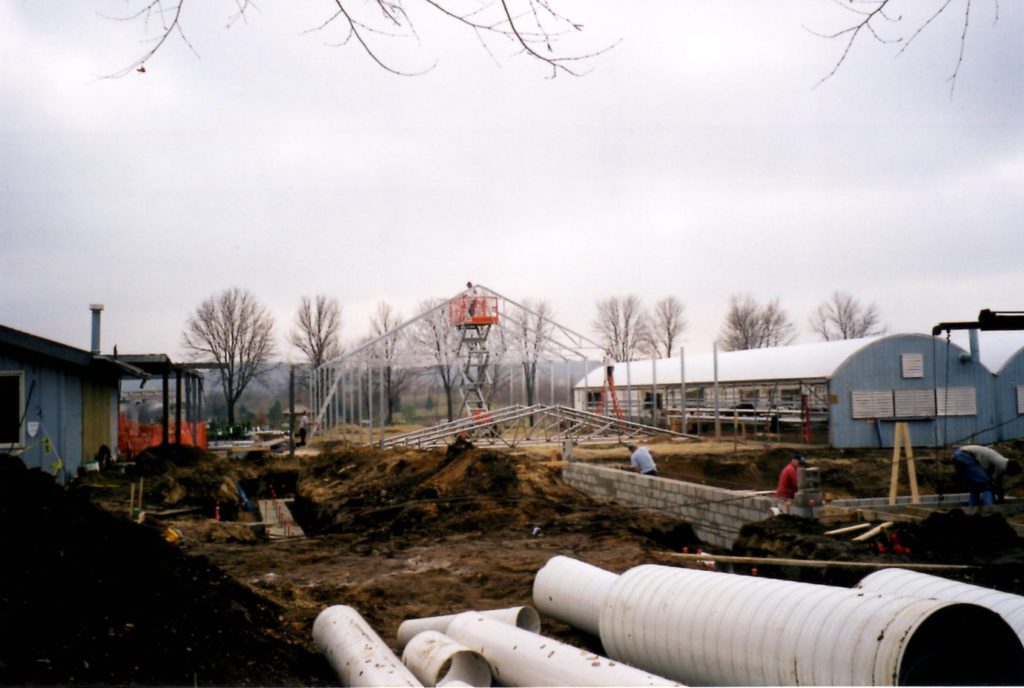
Glass greenhouse construction at Sargent’s North, 2000
– Develop a network: Creating and developing a good network of fellow businessmen, whether in a similar business or not, is another business philosophy that was applied early on. Forrest served as president and was on the board of directors of the Minnesota Nursery and Landscape Association and served on national-level boards for many years. (His father also was president of the state association, and Nick currently serves on its board of directors.) Forrest says, “We have always been involved with the educational and legislative aspects of the industry locally, state-wide, and nationally. We like to see the industry as a whole.”
– Be passionate about what you do: A passion for plants and working in the soil is the reason the Sargent family began its nursery business in 1928 and remains in the business today. Forrest says, “We are very fortunate to make a good living for our family and our employees’ families doing what we love to do.” He recalls, “In the early days of my career, many landscapers decided to change careers around age forty due to body fatigue. That is not nearly as true today because the labor-saving devices make landscape work much less physically demanding. However, that’s not to say landscaping isn’t still very hard outside work that must be done in all kinds of weather. A person needs to enjoy and get satisfaction from a job well done to make this type of work a lifetime career.”
FOLLOWING IN FAMILY FOOTSTEPS
The nursery business is in Forrest Sargent’s blood. His grandfather Forrest H. Sargent opened a nursery, Forrest H. Sargent & Sons, in 1928 on farmland in Red Wing, Minnesota, and he operated it until his death in 1943. Forrest’s father, Maxwell, took over the nursery in 1948, which today is Sargent’s Nursery, Inc., Red Wing. They will mark their ninety-third anniversary this year. Forrest, the oldest of five siblings, worked at his father’s nursery as a child, through high school, and beyond.
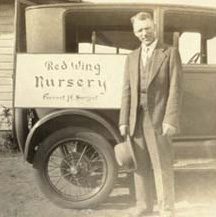
Forrest H. Sargent opened a nursery in 1928 on farmland in Red Wing, Minnesota, and he operated it until his death in 1943.
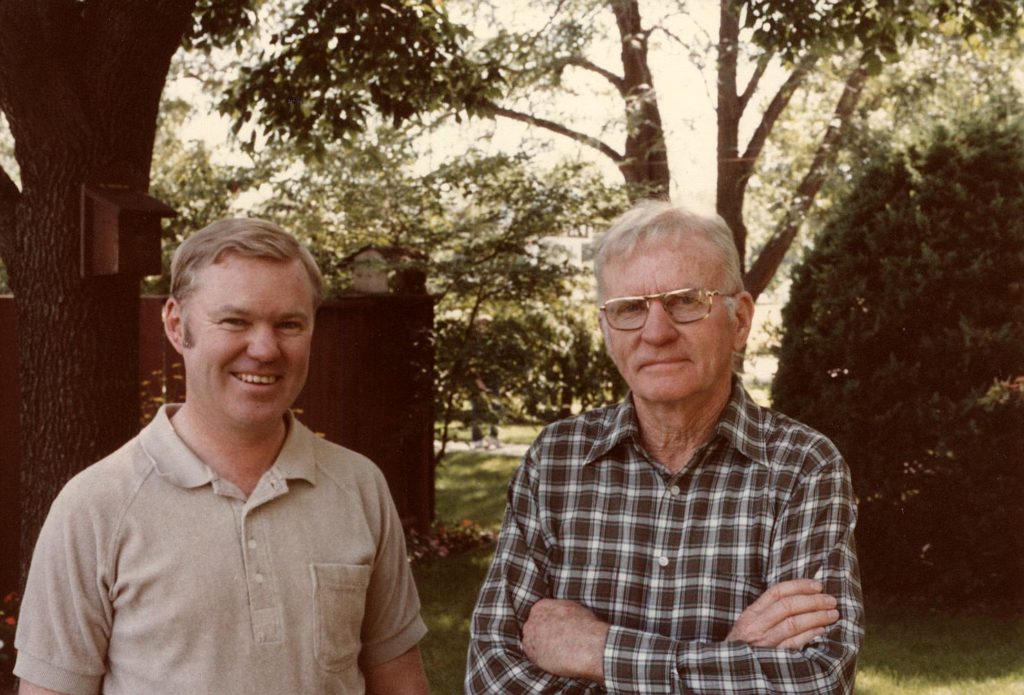
Forrest with his father, Maxwell, the hardest working and most honest person he has ever known.
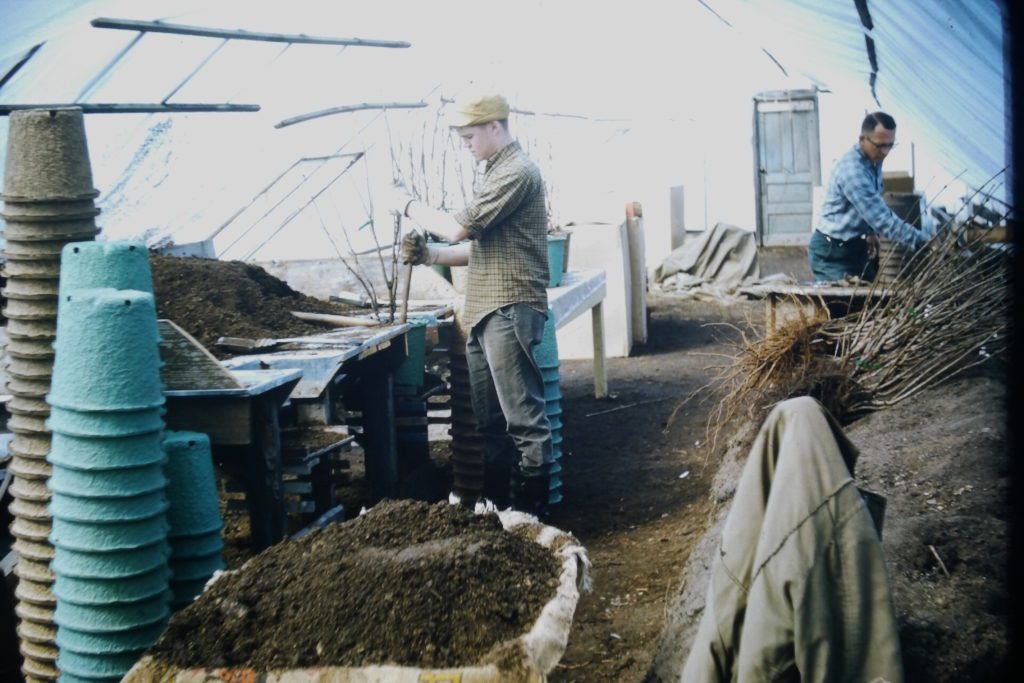 Forrest (center) at his father’s nursery potting bare root woody plants with Dick Bosshard, 1960s. Potting plants was an annual, month-long operation in the early spring.
Forrest (center) at his father’s nursery potting bare root woody plants with Dick Bosshard, 1960s. Potting plants was an annual, month-long operation in the early spring.
As he looks back on Sargent’s fifty years in Rochester, Forrest thinks of how close he came to following a different path. He majored in history at the University of Minnesota and planned to be a teacher. Following their graduations from the U, Forrest and Faye Krogh were married in April 1968. With the Vietnam War in full swing, Forrest joined the Minnesota National Guard and was on active duty in California until the end of September. When he returned home to Red Wing, all the teaching jobs for the school year were filled. So, instead of teaching, he launched headlong into the family nursery business with no formal business or horticultural training—just his apprenticeship knowledge, ambition, and common-sense instincts. He had the special tutoring of his father and his key assistant, Dick Bosshard, each of whom had a degree in horticulture from the University of Minnesota.Forrest’s father and grandfather each made lasting, positive impressions on him. He says, “My father—a horticultural scientist and an artist with landscape design—was the most important and influential person in my life. He was the hardest working and most honest person I have ever known, and I like to think I got a little of each quality from him.” Of his grandfather he recalls, “I am continually impressed by how daring, aggressive, and on-the-move my grandfather was. Between the years he bought the nursery in 1928 and died in 1943, he developed the business through the Depression years, built a house, and bought nursery equipment (including a John Deere tractor and new truck), all while my grandmother dealt with cancer and another family member with cancer lived with them. Grandfather Forrest was definitely an entrepreneur in his own right.”
Forrest recalls, “The early days, when it seems that all I did was hard work, a career in the nursery business was not too appealing. After I realized I could make a living doing it and became involved in the business side, I found that I very much enjoyed the combination of the work and business management.”
THE FOURTH GENERATION’S LEADERSHIP BEGINS
Nick Sargent helped at the nursery from a young age and became a part-time employee in 1986, so he had a basic knowledge of plants and business when he started college at University of Minnesota’s Carlson School of Management. As he began there, he pondered whether he should he be in the science arena developing new plants, in the design/sales area of landscape architecture, or in business. He picked business because he enjoyed that the most. Nick began working at Sargent’s fulltime following his college graduation in 1996, became the primary business management person of Sargent’s North Garden Center and worked closely with Scott Moon on marketing the entire company.
In 2019, Forrest turned seventy-five and turned the leadership of the company over to Nick along with Jay Maier who was hired as Sargent’s general manager. Scott Moon continues to manage Sargent’s on 2ND.
Forrest says, “My early observations are that this highly capable team is focused on some significant changes to our business model. The new model will take advantage of our strong position in the Rochester market and the growth Rochester is experiencing and is projected to have. I see the leadership team continuing Sargent’s long history of being cautiously aggressive and keeping pace with the Rochester market as it unfolds.
“It has been said,” Forrest notes, “that the first generation has the idea for the business and takes the risk, the second generation makes it thrive, and the third generation ruins it. That means the father did not let go soon enough and did not give the next generation full responsibility to succeed or fail until it was too late.” Fortunately, Sargent’s didn’t fall into that scenario. Forrest says, “I recall that my father gave me the freedom to make decisions and then take responsibility for them. I felt liberated by this. That is the feeling I want Nick to have, and it is my responsibility to ensure that he has it.”
Nick remembers how hard his father worked. “He was on the job from early in the morning until he came home for dinner with our family. After dinner, he would go back out for one or two more appointments with clients at their homes. I never remember him complaining or talking about how long and hard he worked. He just did it, and to his family it was just normal life.” Nick is pleased to be the fourth generation of Sargents to lead the company. He notes that all five of his parents’ grandchildren (the fifth generation—Sophie, Max, Alec, Paige, and Jay) work or have worked at Sargent’s. The most dedicated have been his daughter Sophie (20) and son Max (18). At this point, Max is strongly considering a career in the business as well, so someday, Nick may be “passing the torch” to him.
